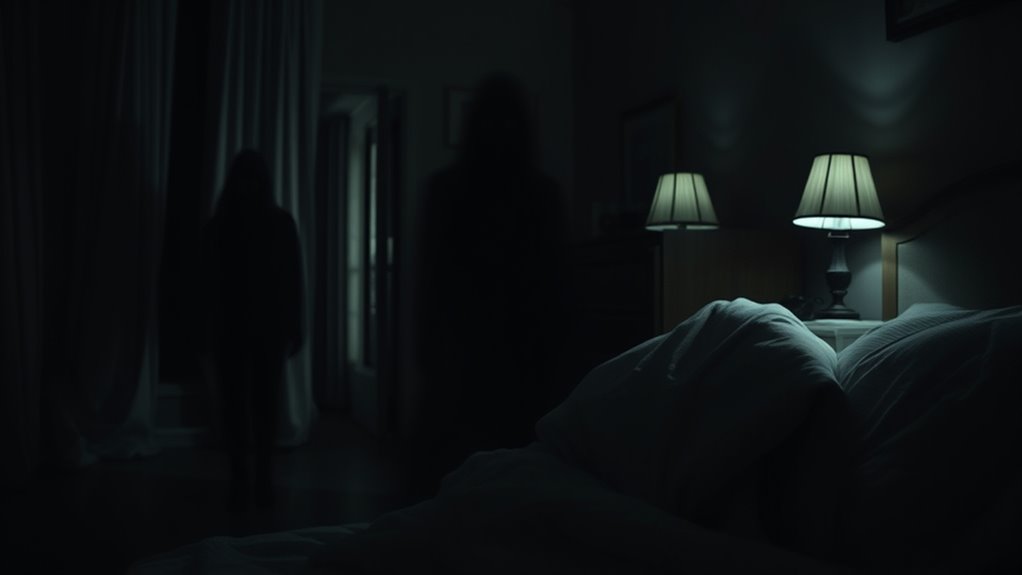Nightmares and night terrors are different sleep issues that can affect your rest. Nightmares are vivid, distressing dreams you remember clearly, often linked to stress or trauma. Night terrors happen during non-REM sleep, causing intense fear or panic but usually with little or no memory afterward. Understanding these differences can help you manage and seek support if needed. Keep exploring to learn more about how these experiences impact your sleep health.
Key Takeaways
- Nightmares occur during REM sleep with vivid recall, while night terrors happen in non-REM sleep with little to no memory.
- Nightmares cause distress and anxiety upon waking; night terrors involve intense fear without clear recollection.
- Nightmares are linked to emotional stress or trauma; night terrors are often related to developmental or sleep disorder factors.
- Nightmares typically allow for detailed recall; night terrors usually involve confusion and disorientation afterward.
- Managing nightmares includes relaxation and sleep hygiene, whereas night terrors often improve with improved sleep habits and safety measures.

Nightmares and night terrors are both frightening sleep experiences, but they differ markedly in their causes, symptoms, and how they affect you. When trying to understand these phenomena, it’s helpful to start with how your mind processes such events through dream analysis. Nightmares are vivid, distressing dreams that typically occur during REM sleep. They often leave you feeling shaken, anxious, or upset upon waking, and you may remember the details clearly. Night terrors, on the other hand, happen during non-REM sleep, often in the first few hours after falling asleep. They involve intense fear or panic episodes that usually occur without detailed recall, leaving you confused or disoriented if you wake up during one. Understanding these differences is vital for managing your sleep health. One key aspect to contemplate is sleep hygiene, which involves habits and practices that promote restful sleep. Poor sleep hygiene—such as irregular sleep schedules, excessive screen time before bed, or consuming caffeine late in the day—can increase the likelihood of nightmares and night terrors. By improving your sleep hygiene, you can reduce the frequency and severity of these episodes. For example, establishing a consistent bedtime routine, creating a calming sleep environment, and avoiding stimulating activities before bed help your brain transition smoothly into sleep. When your sleep is more restorative, you’re less prone to disruptive dreams or episodes of night terrors. Additionally, sleep environment plays a crucial role in preventing these disturbances. Dream analysis can also provide insight into why you might be experiencing nightmares. If you keep a dream journal, you can identify recurring themes or triggers that contribute to distressing dreams. Sometimes, nightmares reflect unresolved stress, anxiety, or trauma. Addressing these underlying issues through therapy or stress management techniques can lessen their occurrence. Night terrors, however, are more often linked to developmental factors or sleep disorders rather than emotional processing. They tend to resolve on their own over time, especially with improved sleep hygiene and reduced stress. While nightmares are generally manageable through techniques like relaxation exercises, avoiding frightening media before bed, and practicing good sleep hygiene, night terrors may require a different approach. Ensuring a safe sleeping environment, reducing stress, and maintaining regular sleep patterns are essential. If night terrors persist or notably disrupt your sleep, consulting a healthcare professional is advisable. Ultimately, understanding these distinctions allows you to better tailor your strategies, ensuring restful nights and healthier sleep habits.
Frequently Asked Questions
Can Nightmares or Night Terrors Indicate Underlying Mental Health Issues?
Nightmares and night terrors can sometimes signal underlying mental health links, but their symptom significance varies. If you frequently experience intense nightmares or night terrors alongside anxiety, depression, or PTSD, it might indicate deeper issues. However, occasional episodes are common. Pay attention to how these experiences affect your daily life, and consult a mental health professional if they become persistent, as they could reveal important underlying mental health concerns.
Are Children More Prone to Night Terrors Than Adults?
Imagine a child’s quiet sleep suddenly interrupted by a terrifying scream, their childhood fears surfacing in the darkness. You notice children are more prone to night terrors due to their developing sleep patterns, which make them more vulnerable to these intense episodes. Unlike adults, kids experience night terrors more frequently, often during deep sleep stages, leaving parents worried but reassured that it’s a normal part of childhood development.
What Are Effective Treatments for Recurring Night Terrors?
If you’re dealing with recurring night terrors, you can try behavioral therapy to help manage them. Establishing a calming bedtime routine and reducing stress can make a big difference. In some cases, medication options like low-dose antidepressants or anti-anxiety meds might be recommended by a healthcare professional. Remember, working with a specialist can help develop a tailored plan to reduce night terrors and improve your sleep quality effectively.
How Can Parents Differentiate Between Nightmares and Night Terrors?
You might find it tricky to tell nightmares from night terrors, especially during a sleep disturbance. Usually, nightmares occur during REM sleep, causing your child to wake up upset or scared, and parental reassurance helps them feel safe. Night terrors happen in deep sleep, and your child might scream or thrash without waking fully. Recognizing these signs helps you respond calmly, easing their distress and ensuring they feel secure.
Do Sleep Environments Influence the Occurrence of Nightmares or Night Terrors?
Your sleep environment and bedtime routines can markedly influence whether you experience nightmares or night terrors. A calming, dark, and quiet sleep space helps reduce stress and anxiety, lowering nightmare frequency. Consistent routines signal your body it’s time to wind down, preventing night terrors caused by sudden awakenings. Avoid screens and heavy meals before bed, and maintain a regular schedule to promote peaceful sleep and minimize these disturbances.
Conclusion
Understanding the difference between nightmares and night terrors helps you recognize and address these sleep disturbances better. Did you know that about 1-6% of adults experience night terrors, often without even remembering them? This surprising statistic shows how common night terrors are, especially in children. By knowing what sets nightmares apart from night terrors, you can seek appropriate help or coping strategies, leading to better sleep and overall well-being. Don’t overlook these signs—your restful nights depend on it.









